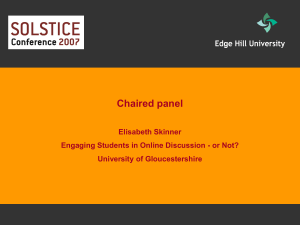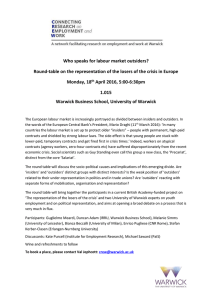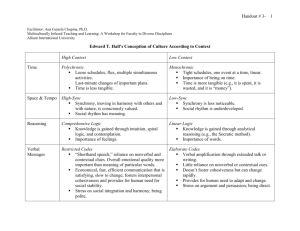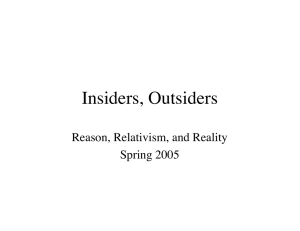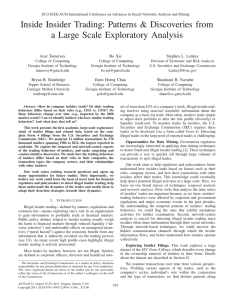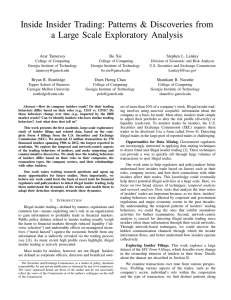Employment Policy and Corporate Governance: An Empirical Analysis on the
advertisement
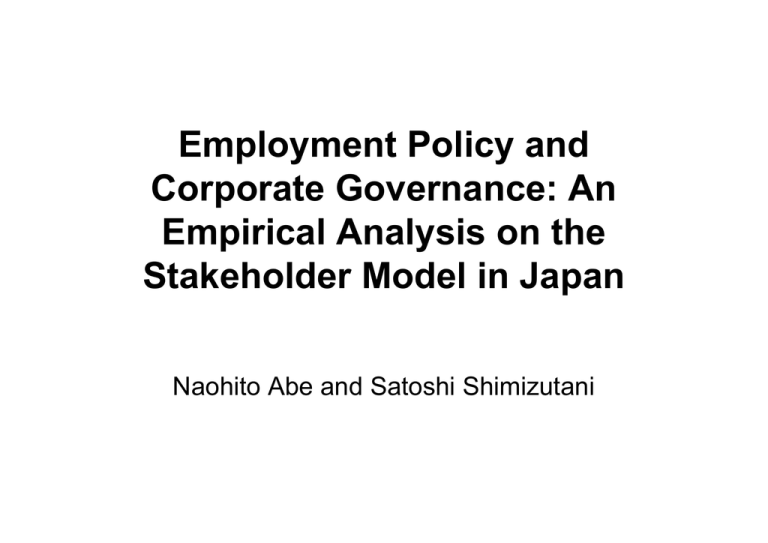
Employment Policy and Corporate Governance: An Empirical Analysis on the Stakeholder Model in Japan Naohito Abe and Satoshi Shimizutani Two Types of CG Model • Classical View • Stakeholder View • Managers are maximizing company’s profit. • Joint determination among many stakeholders including employees. • Possible problems: (1) Agency problem between managers and shareholders (2) Exploitation of minority shareholders • Possible problems: (1) might not maximize profits for the sake of stakeholders (2) might cost more for outsiders Comparisons of CG Japan Select Directors Directors audit Selection Select Auditors Auditors Shareholder President President US Select Insider Board Board outsider Direct CEO CEO Managers Managers Report Shareholder Chair Chair Characteristics of Japanese CG • • • • Infrequent hostile takeovers Insider dominated boards Long-term employment Inactive shareholder’s meeting…… Like Germany, some regard this as an employee oriented stakeholder model (Blair and Roe 1999) Used to be interpreted along the “conditional governance” model (Aoki (1994)) Figure 1 Employees and Retun On Assets of Listed Companies in Japanese Manufacturing 1990:2001 0.1 ROA 2100 0.05 2000 0 1900 -0.05 1800 -0.1 2001 2200 2000 Employees 1999 0.15 1998 2300 1997 0.2 1996 2400 1995 0.25 1994 2500 1993 0.3 1992 2600 1991 0.35 1990 2700 Figure 2 Unemployment Rate and Employees 6 2700 2600 5 2500 4 2400 2300 3 2200 2100 2 2000 1 2001 2000 1999 1998 1997 1996 1995 1994 1993 1992 1991 1800 1990 1900 0 Employees in Listed Companies Unemployment Rate Proportio Ownership Ownership Ownership Bank n of board ROA Share: share: Number of ROA (Profit Board Size Share: The Appointed members (Operating Financial Foreign Employees before Tax) Special Few Director that are Income) institutions investors insiders Year (number of firms) 1991 (1060) Mean Median S.D. Max. Min. 17.85 16 6.90 55 6 0.4712 0.4539 0.1341 0.8747 0.0173 0.3429 0.3375 0.1563 0.7834 0.0040 0.0374 0.0188 0.0601 0.7391 0.0000 0.4906 0 0.5001 1 0 0.7003 2595.0020 0.7405 953.5 0.2188 6309.7830 1 79801 0 28 0.0529 0.0492 0.0375 0.3419 -0.1992 0.2391 0.2443 0.7253 1.8425 -17.6487 1996 (1152) Mean Median S.D. Max. Min. 17.75 16 6.8 60 4 0.4681 0.4484 0.1354 0.8764 0.1628 0.3188 0.3174 0.1472 0.7067 0.0032 0.0588 0.0311 0.0761 0.6641 0.0000 0.5000 0.5000 0.5002 1 0 0.6645 2351.3010 0.7 886 0.2186 5785.4810 1 75590 0 20 0.0309 0.0304 0.0375 0.1952 -0.1851 0.1161 0.1364 0.4914 3.4981 -10.9893 1997 (1175) Mean Median S.D. Max. Min. 17.7 16 6.8 61 6 0.4679 0.4495 0.1376 0.9179 0.0361 0.3163 0.3115 0.1503 0.7022 0.0031 0.0598 0.0314 0.0790 0.6868 0.0000 0.4877 0 0.5001 1 0 0.6678 2277.3510 0.7143 846 0.2177 5631.1000 1 72193 0 22 0.0368 0.0342 0.0367 0.1814 -0.2092 0.1478 0.1517 0.3600 2.4421 -4.0226 2001 (1121) Mean Median S.D. Max. Min. 14.7 14 5.3 63 6 0.4662 0.4440 0.1478 0.9519 0.0294 0.2726 0.2474 0.1530 0.7012 0.0015 0.0647 0.0203 0.0953 0.7667 0.0000 0.4808 0 0.4999 1 0 0.6326 1981.4810 0.6667 746 0.2254 4883.8270 1 66005 0 15 0.0366 0.0327 0.0410 0.2567 -0.1920 0.0318 0.1046 0.7224 15.7157 -5.7298 Japanese Companies in the 1990s • Commercial codes: Introduction of US style CG • Decline in Profitability • Reduction of # of Employees • Diversification in (A) Ownership (Financial ↓ Foreign ↑) (B) board structure (Outsider ratio↑) →Profit Maximizing Model & traditional stakeholder model coexist Previous Studies : CG in Japan No agreements on the role of outside directors ・ Kaplan & Minton (1994) Appointing of outsiders substantially raises the probability of turnover of incumbent top executives. (Fortune1981: 119 firms ). ・ Kang & Shivdasani (1995) (Moody 270 firms) Abe (1997) (Kaisha Rireki Souran 1112 firms) Outsiders have no effects on the sensitivity of turnover to firm performance. Previous Studies : LA in Japan (1) Most of studies: employment adjustment speed ln E t = τ 0 + τ 1 ln Qt + τ 2 ln E t −1 Abe(1999),Urasaka & Noda (2001),Suruga (1997)…. Defects: 1. Observe only net change in employment. 2. No distinction among reducing measures. 3. Assume the same functional form. Previous Studies : LA in Japan (2) • Kang & Shivdasani (1997) Higher portion of mainbank in ownership, higher probability to layoff • Suruga (2002) Probit analysis on the voluntary retirements. Defects: no measure for the necessity of reducing labor costs, i.e. excess employment (K&S: firms whose sales declined more than 50%) Aim of our paper How the change in CG (board composition, ownership structure) affect labor restructuring? ・ Integrated data on (a) measures to reduce labor costs, (b) measure of excess employment, (c) board composition and (d) financial data. ・ Measures: reduction in (1) bonus, (2) wages, (3) managers’ salaries, (4) executive payments, (5) working hours, (6) new hiring & Expansions in (7) lay-offs, (8)earlier or voluntary retirements. Data (1) Annual Survey on Corporate Behavior in 2001 (Kigyou Kodo ni Kansuru Anketo Chousa) ・ Annual survey (January) complied by CAO. ・ Samples: All listed companies. ・ Response Rate: 50.8% for the 2001 Survey (Manufacturing 719, non-manufacturing 483). ・ The survey contains information on (1) Degree of excess employment and (2) Downsizing Measures (3) Expectation of GDP, industry growth. Data (3) • Toyo Keizai : “Directors Data” • NEEDS : “Firm Shareholding Data”, company financial statements Board Structure: Insiders: board members promoted among employees vs. Outsiders: Others Ownership Structures : Foreign or Financial Ownership, Special few (Degree of concentration) Basic Statistics (all) Mean Proportion of insiders 0.6726 among board members 2393.07 No. of employees 15.1552 Board size Percentage of shares 0.4448 owned by the Special Percentage of shares 0.3043 owned by financial Percentage of shares 0.0737 owned by foreigners Bank-appointed director 0.5020 18.0979 Total assets (Natural Expected rate of 5.6714 industry growth (.01%) 6.9980 Excess employment ROA (Operating 0.0379 N=496 Median S.D. 0.7143 0.2038 1 1002 14 5187 5.2557 54017 36 0 0.1407 1 0 0.2817 0.1559 0.7012 0.0037 0.0281 0.1007 0.6120 0.0000 1 18 Max. Min. 0 33 6 0.5005 1.3106 1 22 0 15 5 32.7074 150 -200 7 0.0343 1.0627 0.0397 12 4 0.1794 -0.1716 Degree of Excess Employment VariablesNo. of obs Percent Cum. 2 40 0.4 Excessive by more than 5 12 Excessive by 50% 11 0 0 1.21 Excessive by 40% 10 4 0.81 1.21 Excessive by 30% 9 27 5.44 6.65 Excessive by 20% 8 121 24.4 31.05 Excessive by 10% 7 163 32.86 63.91 No excess employment 6 164 33.06 96.98 Short by 10% 5 11 2.22 99.19 Short by 20% 4 4 0.81 100 (Note) There were no firms that responded that employment was short by more than 30 Basic Statistics (firm with EE) Mean Median S.D. Proportion of insiders 0.6703 0.7059 0.2010 among board members 2405.96 1065 4943 No. of employees 15.0252 14 5.1188 Board size Percentage of shares 0.4389 0.4090 0.1381 owned by the Special Percentage of shares 0.3096 0.2927 0.1562 owned by financial Percentage of shares 0.0724 0.0285 0.0981 owned by foreigners 1 0.5007 Bank-appointed director 0.5110 18.1289 17.9827 1.2845 Total assets (Natural Expected rate of -1.3675 0 35.4833 industry growth (.01%) 7.6215 7 0.7806 Excess employment ROA (Operating 0.0315 0.0289 0.0344 N=317 Max Min 1 0.0909 54017 35 100 7 0.7990 0.0383 0.6771 0.0217 0.5719 0.0001 1 0 22.1460 14.7613 142 -200 12 7 0.1400 -0.1716 Specification Prob (Measures to reduce labor costs(i)) = f(firm characteristics, board [banker, shareholder, size, insider], firm performance, excess employment) 8 Categories of Measures (multiple answers) Decrease in 1. Bonus, 2. Wage, 3. Managers' Salaries, 4.Executive Payments, 5. Working Hours, 6.New Hiring Expansion in 7. Lay-offs, 8. Earlier or Voluntary Retirement Mutivariate Probit Model: SUR version of probit Results:Multivariate probit Findings ・Firms with a higher share of outsides are more likely to lay off staff or resort of voluntary early retirement, while boards consisted of insiders are more inclined to reduce new hiring. ・Consistent with the stakeholder view: Insiders are more concerned with protecting the interests of employees than with profitmaximization as assumed by neoclassical theory. Endogeneity issues Kaplan & Minton (1994),Morck & Nakamura (1999): Appointments of outside directors are endogenous and correlated with companies’ performance. → lagged variable ( 5 years) as IV. → Similar results (Table 4). The negative effect on bonus reduction: Firms with a higher share of insiders does not reduce bonus and keep the remuneration level at the cost of shareholders. Conclusion and implication (1) 1. First study to examine how changes in board composition and ownership structure affected their labor restructuring to obtain implications of the transformation in corporate governance. 2. Unique integrated firm-level data (1) degree of excess employment, (2) board composition, the ownership structure, (3) labor cost reduction measures (4) financial statement data. Conclusion and implication (2) 3. Our findings: outsiders are more committed to layoffs, and to implementing voluntary or early retirement, while insiders are more inclined to decrease new hiring. Outsiders contribute to the downsizing of employment, whereas insiders are more inclined to protect incumbent employees. 4. These findings are consistent with the stakeholder view rather than the neoclassical view of a firm as a profit-maximizer.
